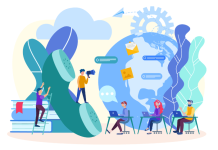
It’s no secret that the customer service industry has taken a significant hit throughout the COVID-19 pandemic.
Between angry customer phone calls, miscommunication, insufficient staff, and the overall exasperation of the general public, the pressure was on for call center agents as they navigated the tumultuous terrain of a COVID-fatigued population.
However, the call center agents answering the phone aren’t the only ones who have been receiving flak.
When agents make outbound calls, like to notify customers of issues such as order delays or payment problems, or following up on inquiries, the calls might be ignored or there may be misunderstandings, or the calls may take longer and become more exasperating as a result.
Yet outbound communication has been more critical than ever as agents work to ensure that nothing falls through the cracks and try to retain a state of customer satisfaction when things were, let’s be honest, largely dissatisfying everywhere else.
With such a significant emphasis having been placed on inbound communication and the impact that it has had on customer experiences, many call centers have overlooked the critical effect a successful outbound campaign, with the right tools in place, could have on the overall customer experience (CX).
What Do the Customers Want?
Although software and advanced call center technology are helpful for outbound agents, at the end of the day, it’s all about the overall satisfaction of the customer.
How can call center agents best personalize customer interactions to create outstanding experiences? An intuitive agent interface will streamline and simplify every part of their roles on calls, giving the customer an impression of efficiency and mastery.
The intelligent interface provides the agent with access to all relevant customer data and a front-and-center note-taking panel, enabling a completely personalized interaction with the customer.
A genuine customer connection is the most important tool for a call center agent.
Another method to keep the customers on the outgoing end of the line happy is proactive contact.
Tools such as direct-to-voicemail delivery, a voice broadcasting tool that allows agents to send pre-recorded messages to thousands of contacts all at once, as opposed to manually dialing each customer, can help keep customers informed to the highest degree, ideally eliminating the need for them to call in.
With this solution customers can avoid subscription lapses, credit card expiration issues, missed appointments, and more with a single voicemail.
Call center agents also must be equipped with multiple layers of business intelligence that can help narrow the margin for error and deliver the most personalized experience possible.
A genuine customer connection is the most important tool for an agent.
And part of these interactions is doing a little behind-the-scenes matchmaking to pair a customer with a fitting agent. Software that is particularly useful in handling high-risk calls, high-value clients, and complex issues can match the right kind of agent to the customer.
Artificial intelligence (AI) can be leveraged to analyze agent aptitude data and connect the customers with the perfect agents based on the reason for their calls, thus raising the chances for genuine connections.
How Do You Make the Connection?
An outbound call center’s primary focus should be implementing efficient scripts and practices that ensure positive CXs.
It is essential to get straight to the point in a kind and professional way for the customer to have no questions about the reason for the call. It is critical that the call center agent knows the call’s subject matter before dialing and adjusts their manner accordingly. For example, agents may approach customer callbacks differently than they would debt collection.
Furthermore, it’s important that agent-customer interactions are recorded through call center software. Understanding what occurred on the calls allows a plan of action for performance improvement and professional development.
But in order to understand these interactions, agents have to be equipped with the proper tools for maximum efficiency.
A helpful way to increase that connection with customers is through speech recognition software. This kind of software works to identify specific words and phrases that agents are looking for. The more agents listen to their customers, the better the overall CX.
In addition, speech analytics software can identify certain words, phrases, and silent periods to be compiled into data and applied and analyzed. It can offer a complete understanding of the customers and the ability to leverage best practices for the agents.
Overall, outbound software can increase productivity while raising customer satisfaction and serve as a critical part of customer service practices, such as survey research and collections. Some examples of essential outbound software features are:
- Data services, like list management, allow a call center to augment, review, enrich, and filter data easily and contextually. They can serve as central data repositories for advanced data management. They provide increased visibility and greater administrative control, thus narrowing the margin for error when it comes to keeping the data straight and improving the customer’s overall experience with an outbound agent.
- A call center compliance guide is integral to help call center personnel navigate and research what is allowed under the law. For outbound call centers specifically, it’s important to always follow the parameters set in place, like by the Telephone Consumer Protection Act (TCPA). It is equally critical to keep them updated as regulations change, and new ones are introduced.
- Manual intervention allows call center agents to approve outgoing calls personally. While predictive dialing can be highly reliable, some call centers would like to avoid undue risk to the organization.
- Integrated omnichannel communications will help agents connect outbound calls efficiently and effectively by creating a unified call center. Despite considerable improvements in technology over the last few decades, many call centers are still using outdated methods and technologies. The unification of communication channels can also increase agent productivity, thus increasing customer satisfaction.
How Do You Ensure Outbound Efficiency?
As call centers grow, keeping track of metrics and the service your agents deliver can be a time-consuming task, albeit a necessary one.
The latest tools in workforce optimization (WFO) reduce the time and effort involved in improving performance and addressing training needs while simultaneously allowing agents to start off on the right foot with every interaction.
Agents without the tools they need to optimize their workplace performance is like having a lock with no key to open it. But once agents are equipped with the right solutions, they can unlock their full potential and exceed expectations.
For example, cloud-based call center technologies can minimize the time needed to keep a pulse on each agent with easy-to-use, automated features.
Speech analytics tools automatically flag hot-button words during calls for immediate escalation and use voice analysis AI to determine when emotions ran high during the conversations.
Having a record of these reactions is key to adapting to each customer situationally. The availability of these resources to call center agents, combined with a complete recording of all agent screen activity and automated and real-time notices when agents exceed KPI thresholds, lead to a comprehensive blueprint for guidance and monitoring that will keep everyone at their best and customers satisfied.
How Do Home-Based Agents Make It Work?
The effects of COVID-19 have transitioned many agents from the workplace to home offices. This transition wasn’t an easy one, especially for call centers that weren’t prepared to make these huge adjustments when the pandemic hit. It wouldn’t be a lie to say that panic ensued when it came time to send agents home without the proper equipment to help them stay productive.
A scenario like this is an outbound call center manager’s nightmare. However, the innovations of call center technology have changed how outbound call centers manage agent efficiency outside the office, which was integral in the tumultuous COVID-19 industry shift.
So, what technologies enable the success of a home-based call center agent?
Outbound call center managers can start by integrating predictive dialers into their contact centers. A predictive dialer can be used from any location; all that is needed is an internet connection, making it an ideal tool for remote agents.
A seamless transition to an efficient dialer platform is just the beginning of optimizing performance and productivity.
Another critical tactic for customer satisfaction and agent productivity is regular training opportunities to keep agents engaged, efficient, and up-to-date with current best practices and compliances.
Regular agent training helps to maintain top-tier performance. Even though agents are working from home (WFH), continual training is critical to keep track of KPIs as well as individualized productivity for agents.
Managers may think that there is a barrier between them and WFH agents, especially after working together in an office setting, but that’s not true.
Managers must be accessible; communication between agents and managers need to be improved to build trust with a customer base. Call centers equipped with technology that allows for a transparent window between managers and at-home agents are set to thrive.
The pandemic has caused the call center industry to stop and take stock of productivity practices as well as tactics to increase customer satisfaction.
In a world where customers lived in a state of frustration due to the inability to have in-person interactions, call center agents were often collateral damage of their frustrations.
However, outbound call centers have the ability to remain ahead of the curve. Keeping customers happy through proactive outreach and genuine, personalized interactions between the parties is possible.
Leveraging all the available technologies will aid in the seamless operation of an outbound call center, thus leading to maximum customer satisfaction and optimum agent productivity and happiness, resulting in productive, pleasant interactions.




